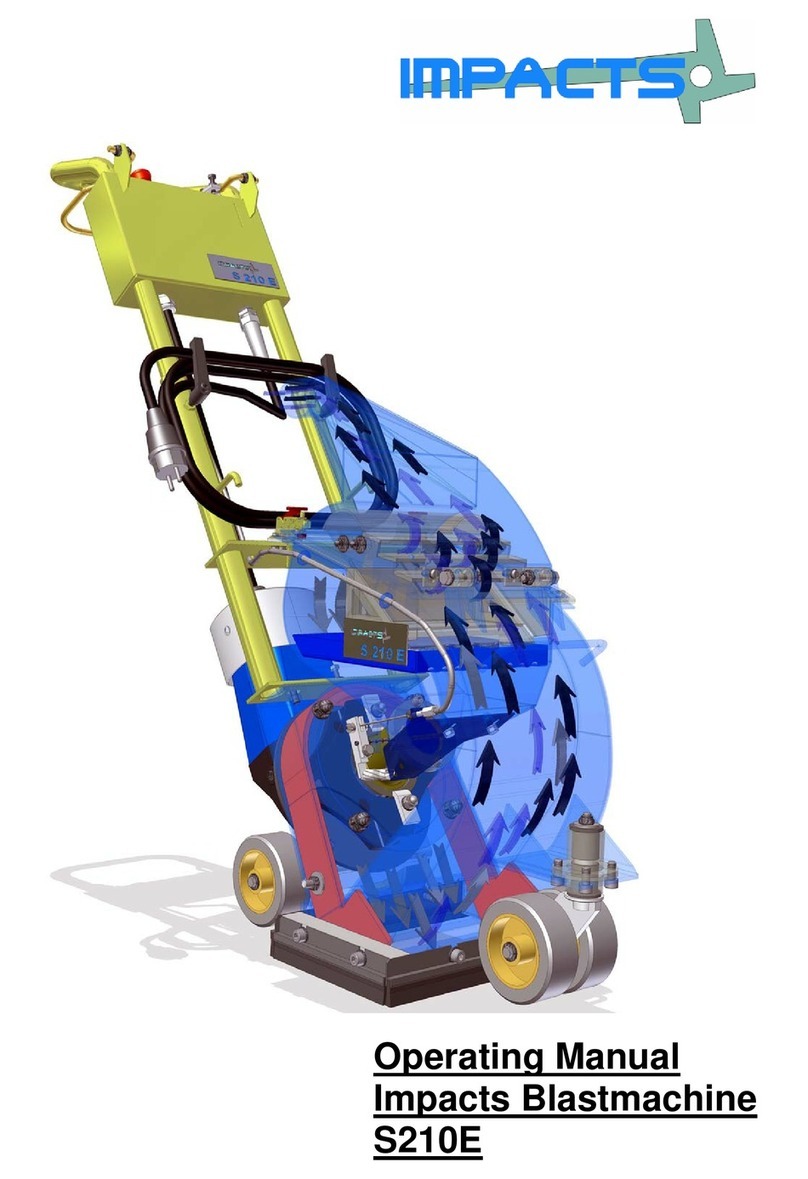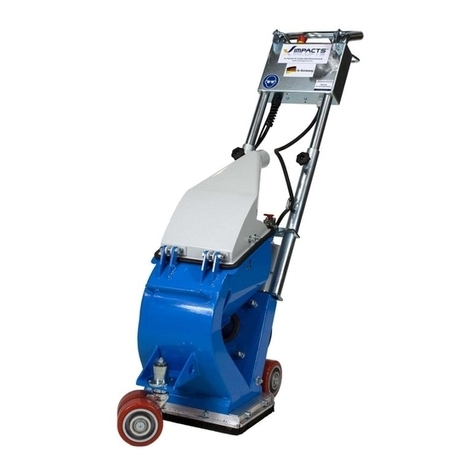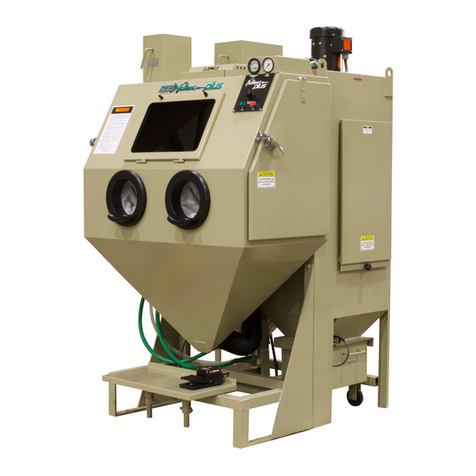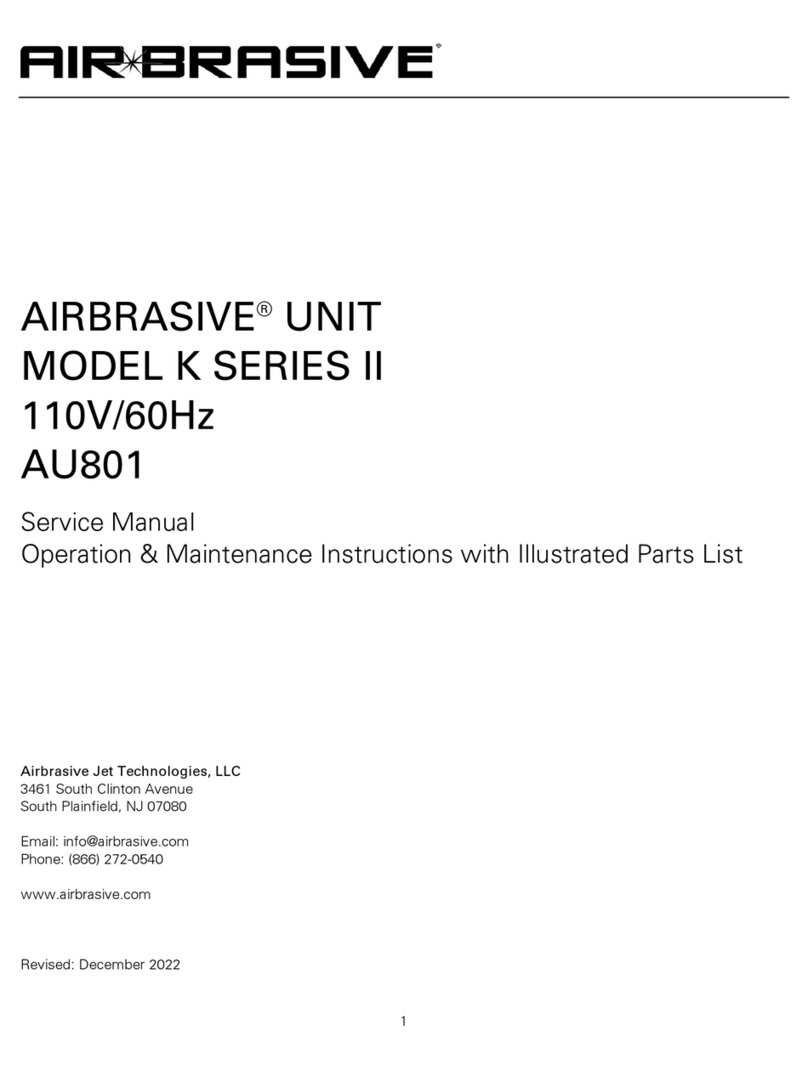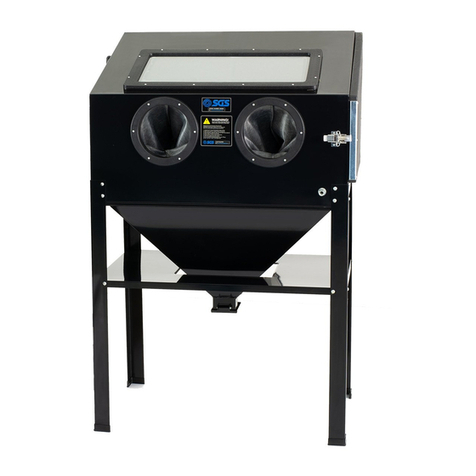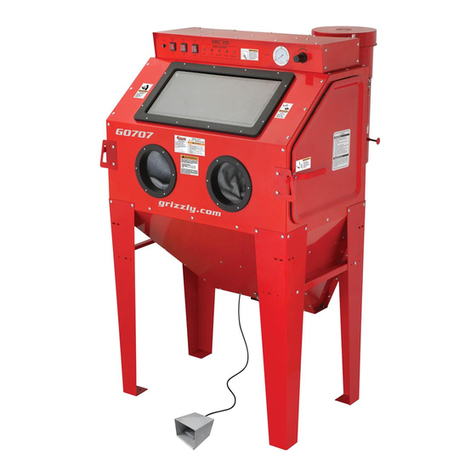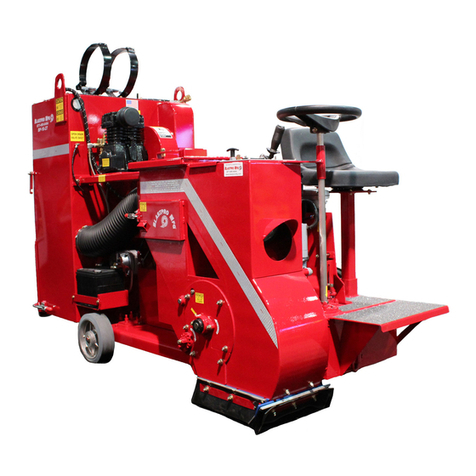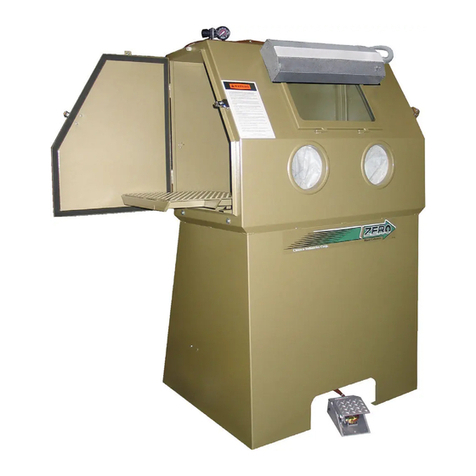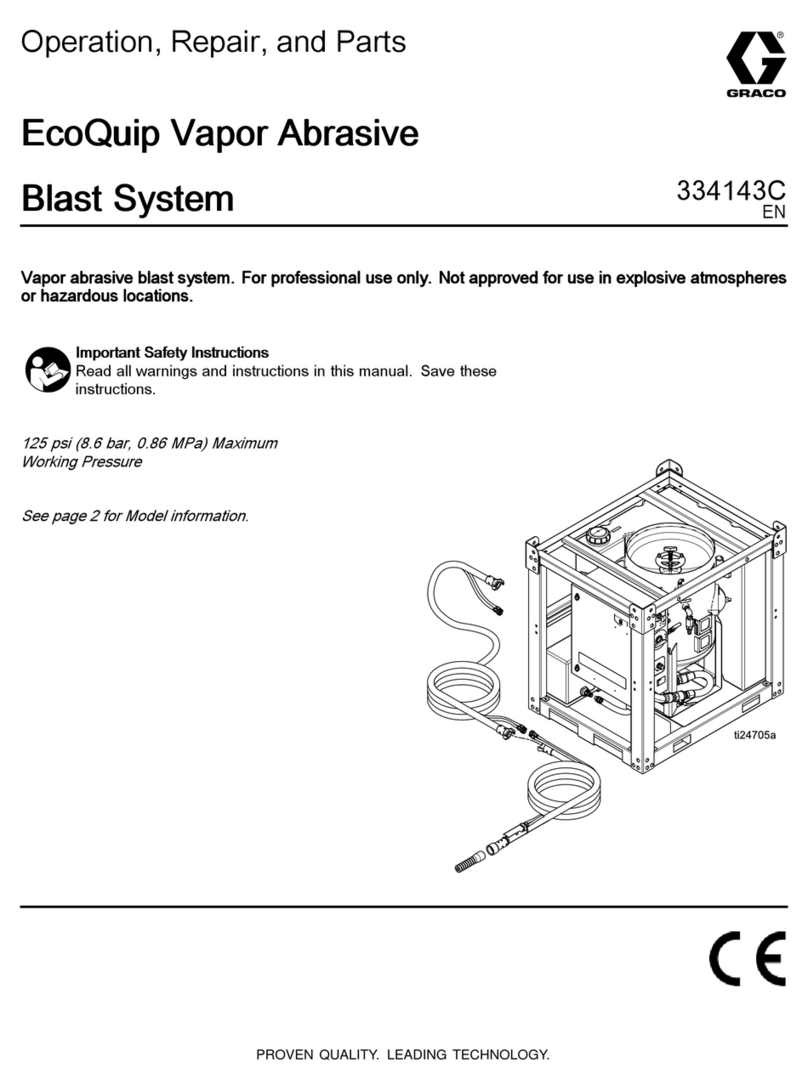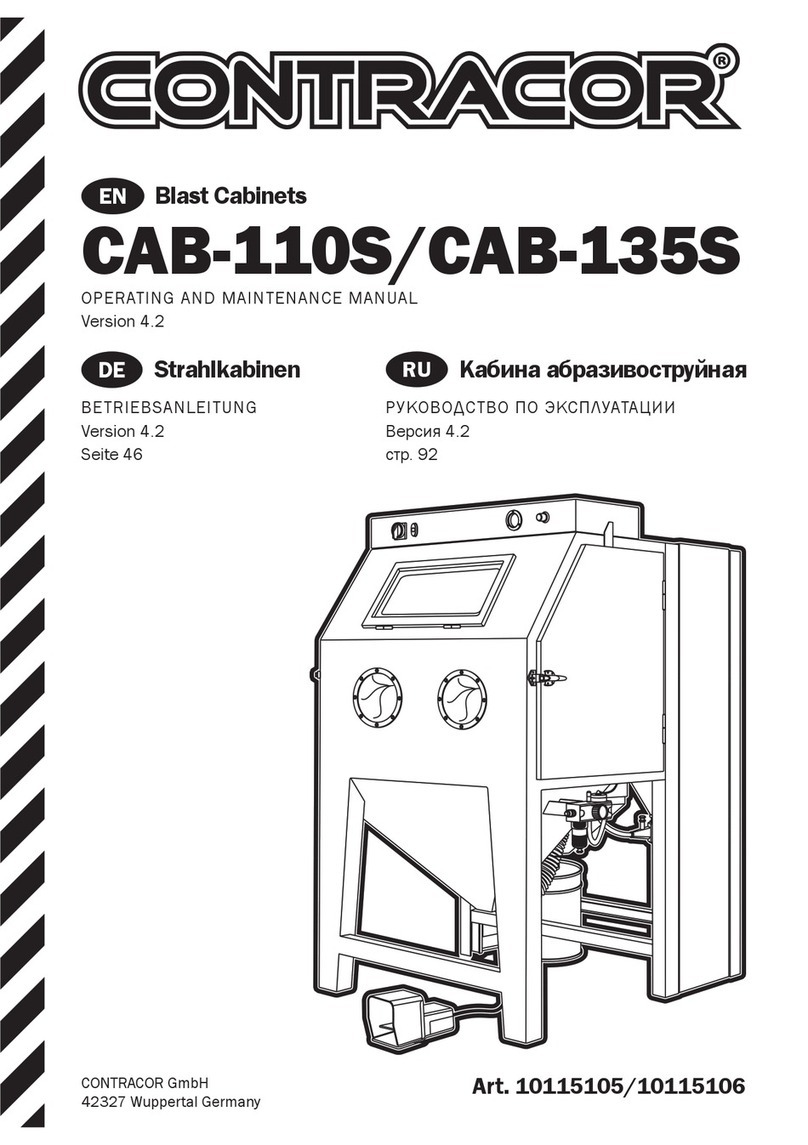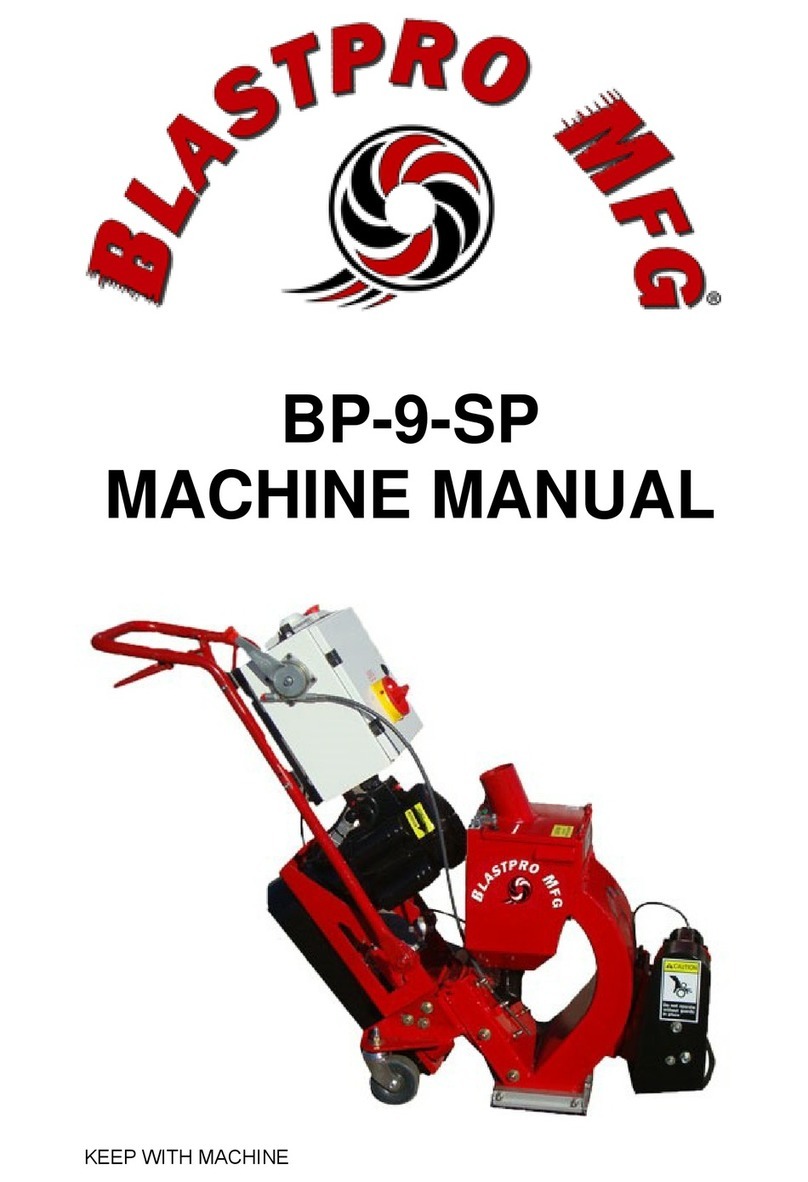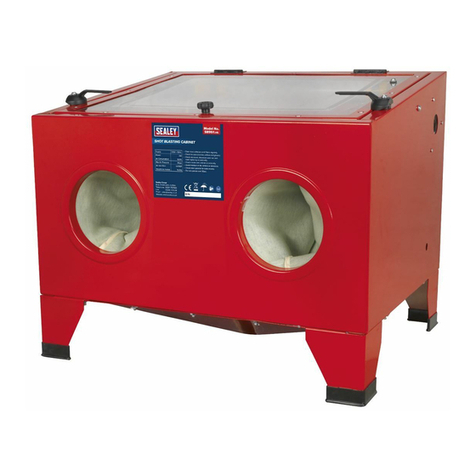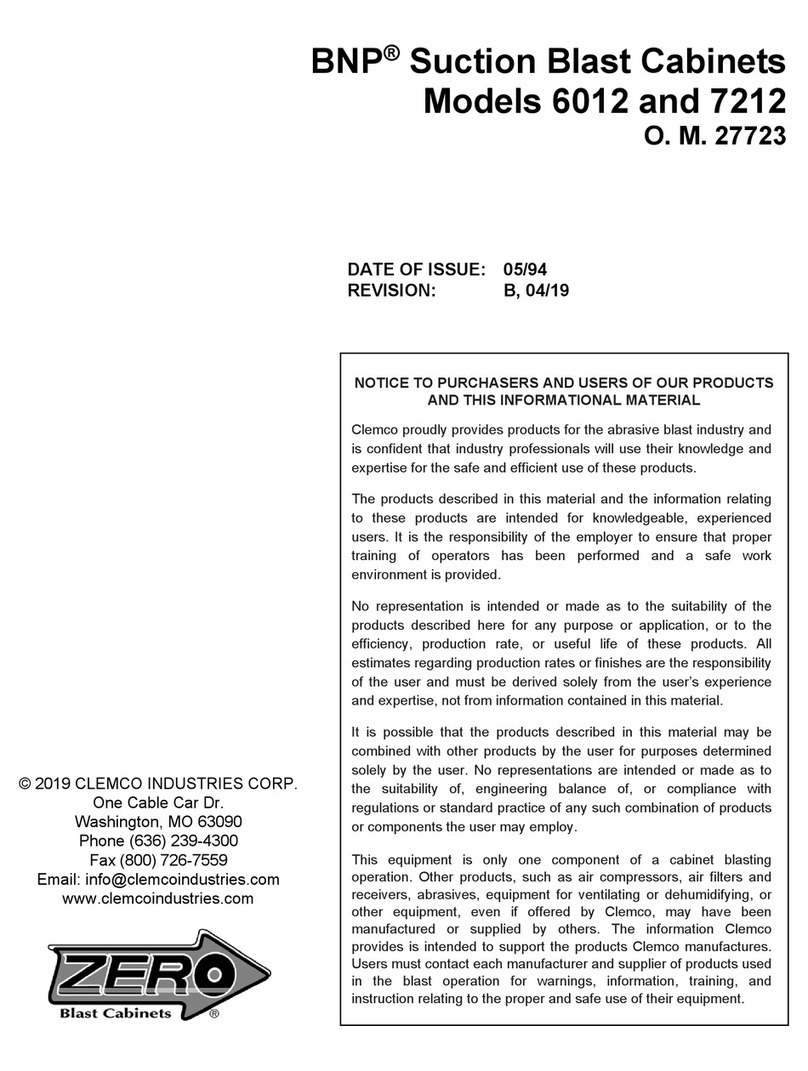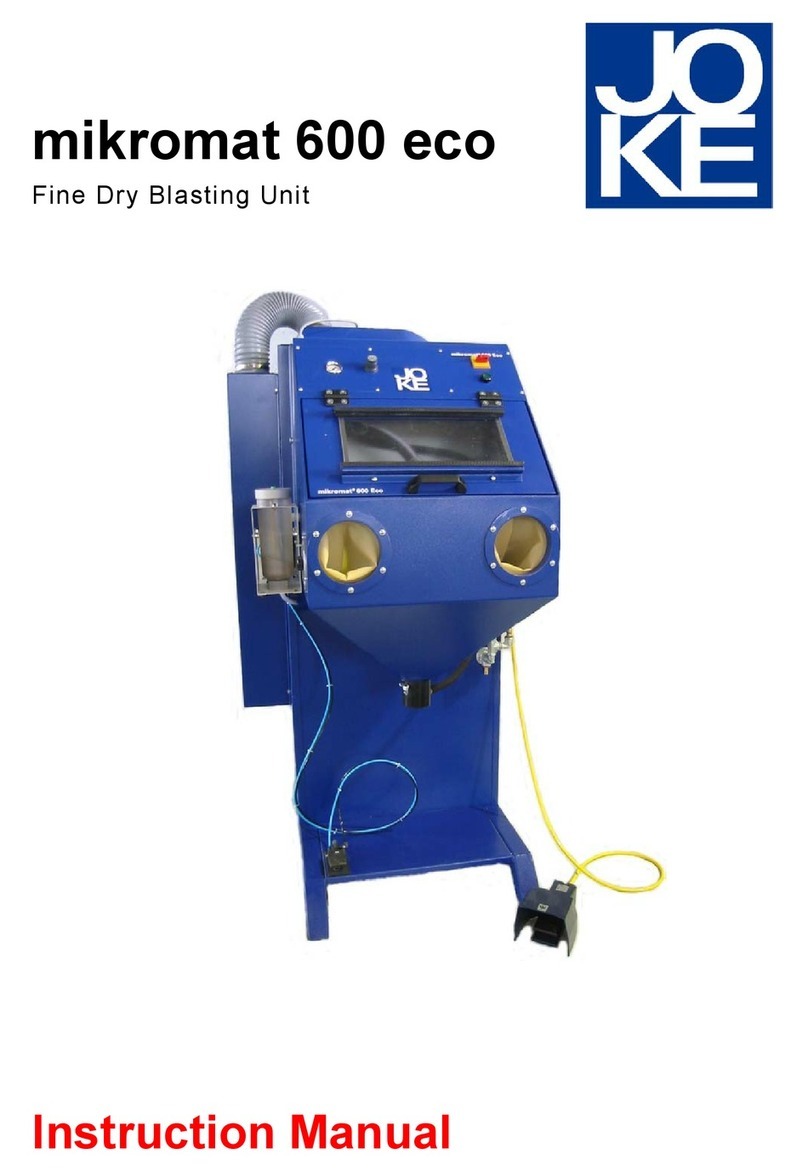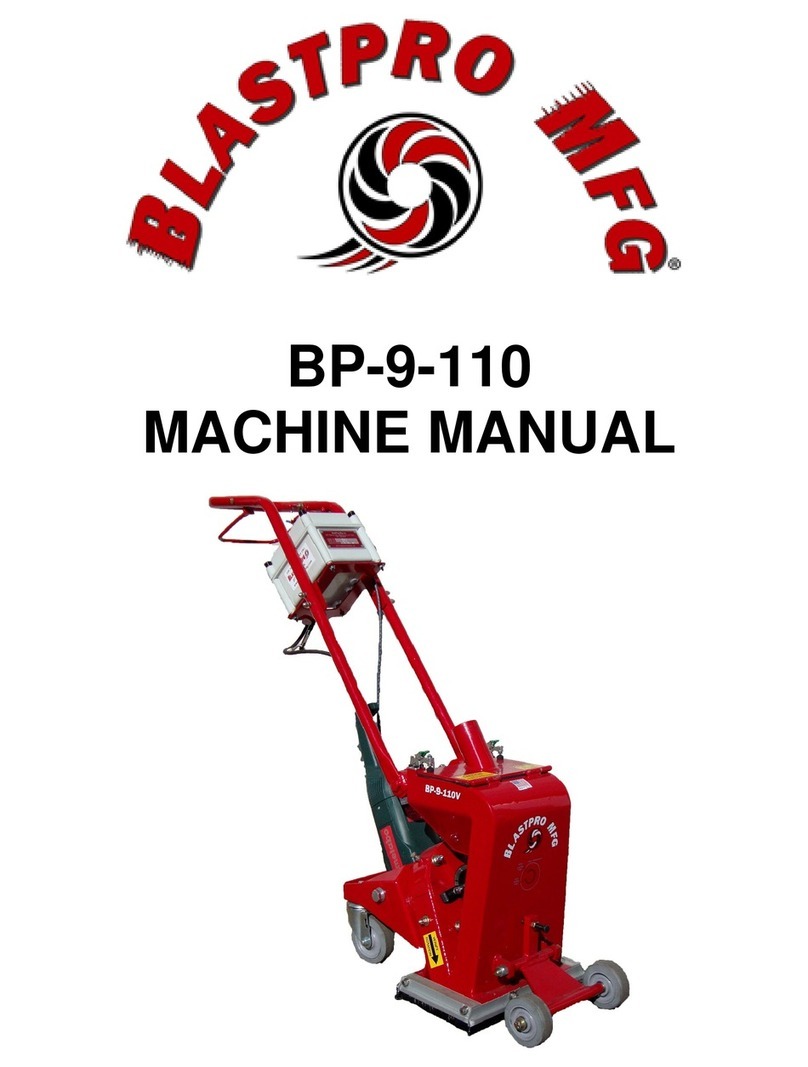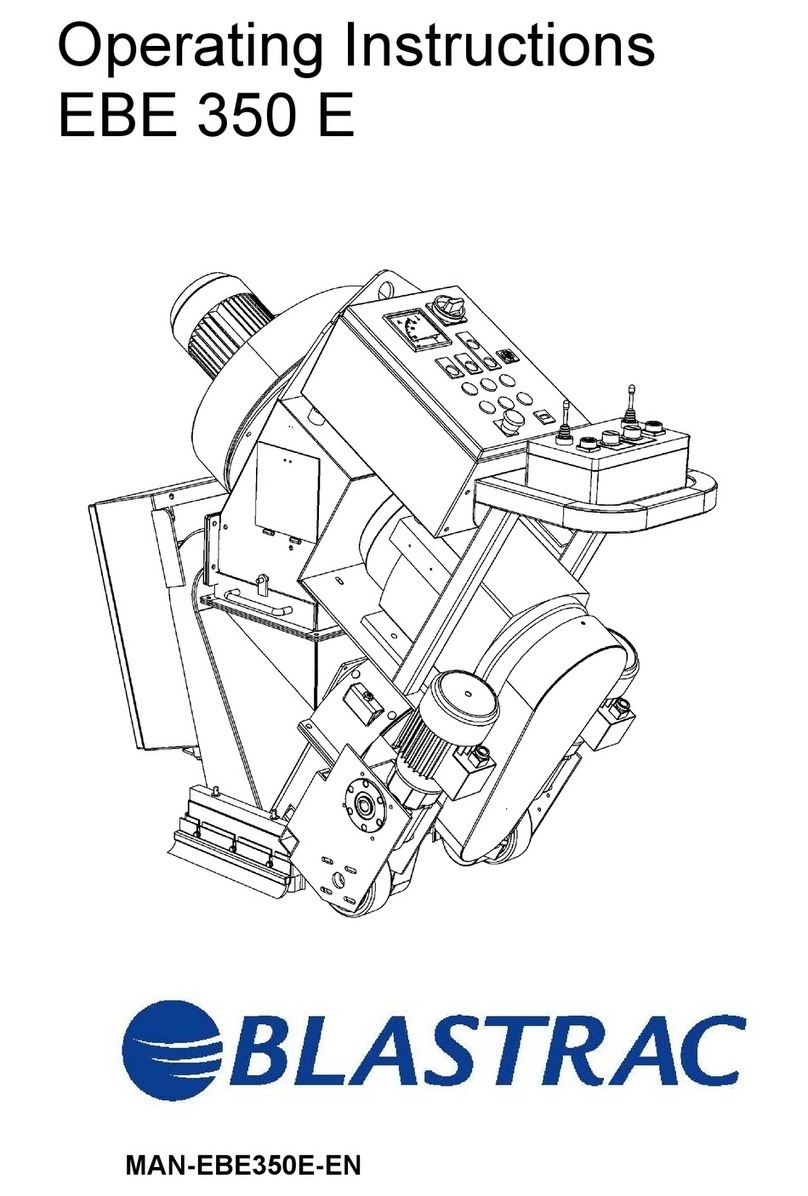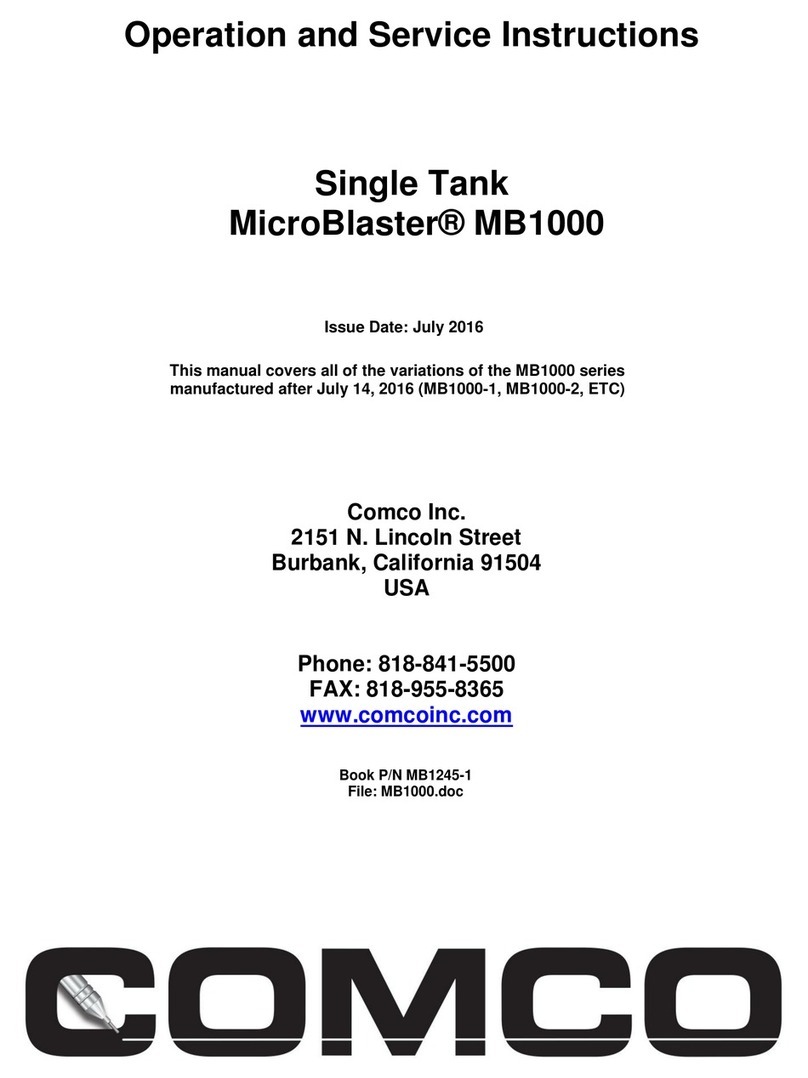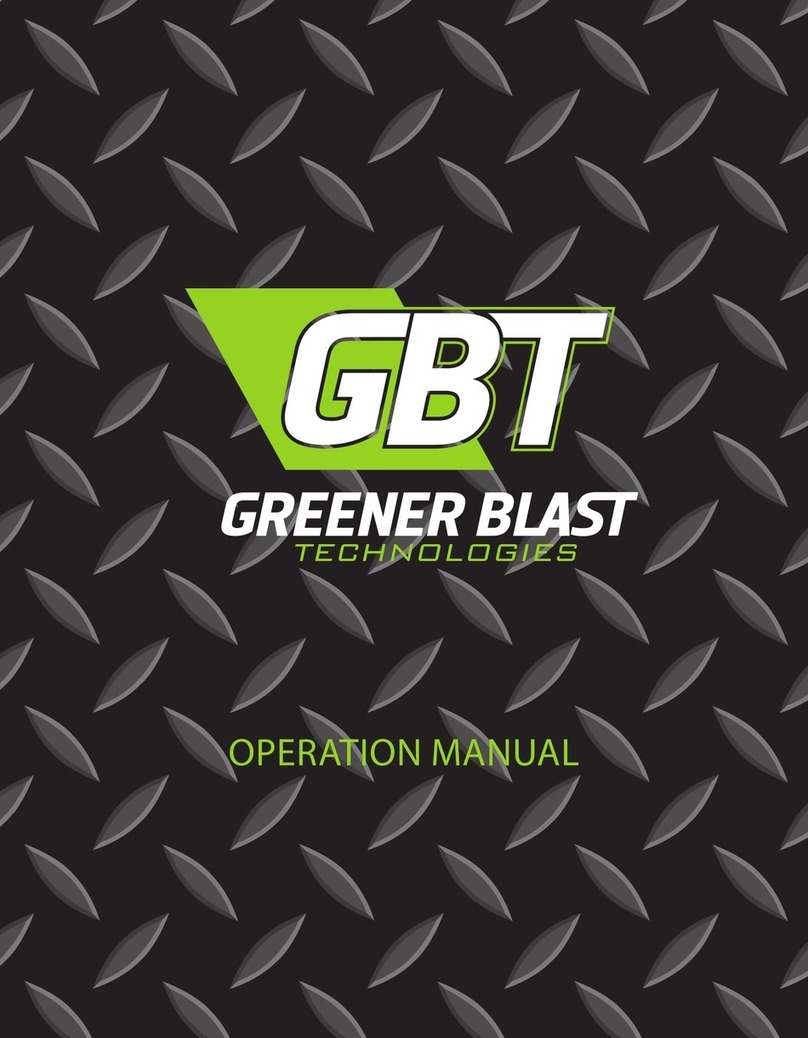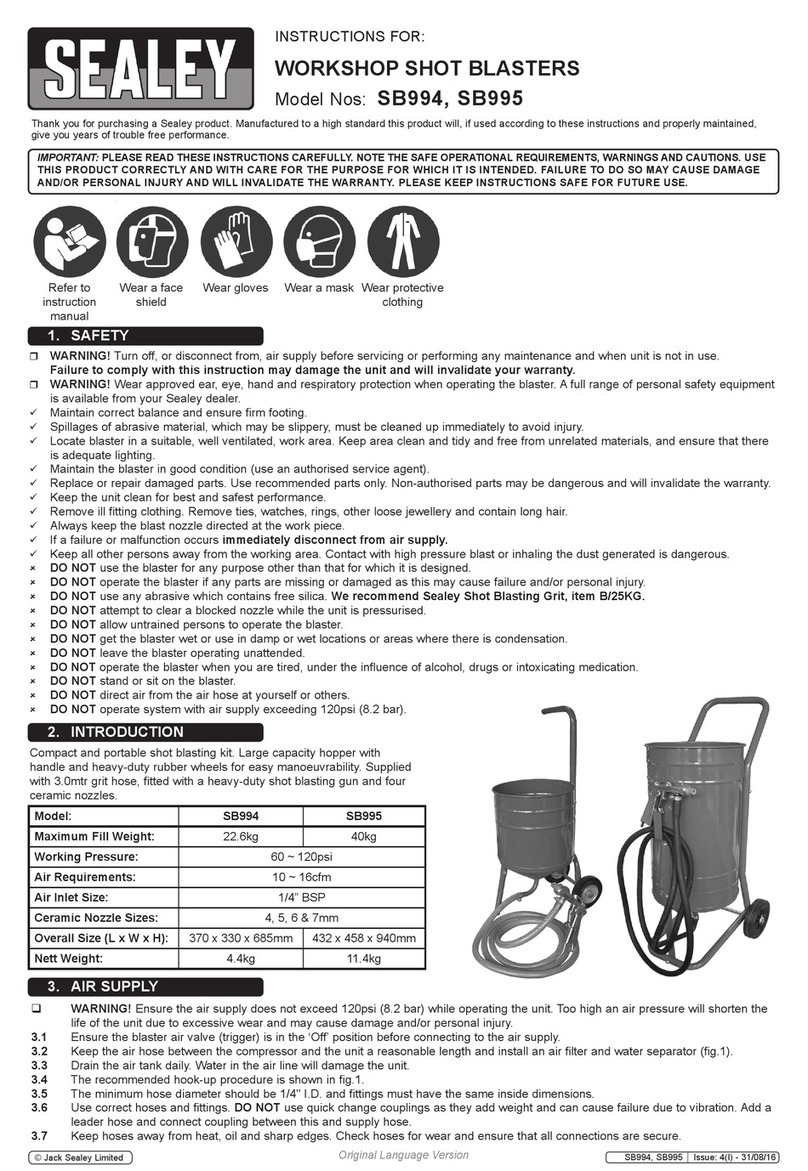Impacts STREAMER S320RD User manual

Operating Manual
S320RD
Your Partner for Mobile Surface Preparation
IMPACTSAmericas.com

IMPACTS Americas
1384 Bungalow Rd.
Morris, IL 60450 USA
(815) 941-4800
(815) 941-4600 Fax
www.IMPACTSAmericas.com
[June 2016]

Operating Manual S320RD
1
Table of Contents
1.0 Technical Data.............................................2
2.0 Safety Instructions .........................................4
3.0 General Information . . . . . . . . . . . . . . . . . . . . . . . . . . . . . . . . . . . . . . . 10
4.0 Transportation............................................20
5.0 Start Up .................................................22
6.0 Operation................................................28
7.0 Maintenance - S320RD .....................................34
8.0 Electrical Systems ........................................50
9.0 Error Diagnostics .........................................54
For spare parts, please refer to a separate
publication called "S320RD Parts Catalog."
Please note: The following safety instructions must be followed as
shown in this operating manual. Failure to do so may result in hazard
to health or possible death.

S320RD Operating Manual
2
Chapter 1.0 Technical Data
1.1 Rating
1.2 Unit Specifications
1.3 Operative Range and Correct Usage
1.4 Advice for L.P. (Propane) Gas Mode
1.5 Advice for Operators of the Blast Machine
1.6 Machine Type Designation
1.1 Rating
Machine: IMPACTS Blast Machine
Machine-Type: S320RD
Manufacturer: IMPACTS Americas
1384 Bungalow Rd.
Morris, IL 60450 U.S.A.
1.2 Unit Specifications
Machine S320RD
Length 81 in. / 2060 mm
Width 34 in. / 864 mm
Height 60 in. / 1520 mm
Weight 1,808 lb. / 820 kg
Engine Kawasaki:
Model FD750D
Engine Type Liquid-cooled, 4-cycle
Number of Cylinders 2
Displacement 745 cm3
Max. Power 17.7 kW (23.7 HP) / 3600 min-1
Consumables:
Capacity (I) Type
Engine Oil 2.0 SAE 10W40 SF, SG, SH or SJ Semi synthetical
Coolant 2.7 e.g. Antifreeze X12 Plus Mixed ratio: 50%
Hydraulic Oil 20 HLP46
Compressor Oil 0.5 API CC/SC SAE40
Gear Box Oil 0.36 e.g. Shell Omala S2 G 150

Operating Manual S320RD
3
1.3 Operative Range and Correct Usage
The blast machine is designed to be used on clean, dry, horizontal surfaces without any
obstacles. The machine cannot be used for any other purpose. The manufacturer will
not be held liable for damages resulting from incorrect usage. In cases of wrong usage,
the user will assume all risks and damages.
1.4 Advice for L.P. (Propane) Gas Mode
Settings or repairs of the L.P. Gas system must only be performed by a specialist. If
there is any gas smell or leak, the Blastmachine must be taken out of operation at once
and the tank shut-off valve must be closed. The Blastmachine must only be taken in
operation again after the cause has been found and removed by a specialist.
L.P. Gas system components, specifically gas lines, must not come into contact with
sharp-edged, hot or rotating parts. Lines must not be bent. The Blastmachine must be
inspected every day, specifically for tightness and tight seat of the gas components.
1.5 Advice for Operators of the Blast Machine
During the operation of the machine, it may be possible to exceed the acceptable noise
levels of 85 dB(A). This is dependent on various locations and circumstances. When the
noise level is 85 dB(A) or more, the machine operator and the persons working near the
machine must wear sound-insulating devices.
1.6 Machine Type Designation
Machine Type: S320RD
Unit / Designation: IMPACTS Blast Machine
Working Width: 12.6 in. | 320 mm
Drive: Progressively adjustable 1-98 ft/min | 0-30 m/min
Blasting Capacity: Up to 2,153 SF/hr | 200 m²/h
Abrasive Consumption: 100-200 g/m²

S320RD Operating Manual
4
Chapter 2.0 Safety Instructions
2.1 Explanation of Warnings and Symbols
2.2 Organizational Measures
2.3 Personnel Selection and Qualification
2.4 Safety Precautions Applicable to Different Operating Conditions
2.5 Repair Work, Maintenance Activities, and Default Repair on the Job Site
2.6 Definition of the Safety Off Position
2.7 Dangerous Aspects of the Machine
2.8 Electrical Engineering Regulations
2.9 L.P. Gas Engineering Regulations
2.10 For Special Attention
2.1 Explanation of Warnings and Symbols
The following symbols are used in the operating instructions to highlight areas
of particular importance:
Operational Safety
This symbol will be shown in these Operating Instructions next to all safety precautions
that are to be taken in order to ensure prevention of injury. Follow these instructions and
take special care in these circumstances. In addition to these instructions, the general
safety precautions and the local accident prevention guidelines also should be followed.
Please check if there are special regulations for the particular job site.
Safety Goggles/ Ear Protection
Information, instructions, and restrictions with regards to possible risks of personal injury
or extensive damage to materials.
Electrical Warning
Warning against dangerous voltages.
Propane Gas Warning
Warning against dangerous aspects of the propane gas system.
2.2 Organizational Measures
Operating Instructions are to be kept near the machine and be attainable all the time.
In addition to the Operating Instructions, general and legal regulations regarding accident
prevention and environmental protection must be indicated every time.
Such duties may, for example, relate to the handling of hazardous substances or to the provision
and wearing of personal protection equipment as well as compliance with local traffic regulations.

Operating Manual S320RD
5
The Operating Instructions must be supplemented by instructions including the duty to supervise
and report relating to particular local working practices; for example, work organization, work
procedures, and personnel allocation.
Personnel working with the machine must read the Operating Instructions before starting the work,
in particular. Chapter 2 "Safety Instructions." This must be done before starting any work with the
machine. This applies to certain activities such as setting up the machine, carrying out maintenance
work, or training staff to work with the machine.
From time to time, the working practices of the staff should be checked regarding awareness of
safety and hazards.
Personnel must tie back long hair and not wear loose clothing or any jewelry. There is
risk of injury in getting stuck or being drawn into moving machinery. Use personal
protection equipment whenever necessary and required by regulations!
Take notice of all safety and hazard signs on the machine. They must be kept complete and legible.
If safety-critical changes occur to the machine or its performance, the machine must be
shut down immediately! The cause of the fault must be determined immediately and be
repaired before starting work again.
Changes, add-ons, or conversions which might have an influence to the safety of the machine
must not be undertaken without the permission of the manufacturer. This applies in particular to the
fitting and adjustment of safety devices and to welding on major and load bearing parts.
Spare parts must always comply with the technical requirements and the specification of the
manufacturer. Original spare parts by the manufacturer are guaranteed compliant.
Inspection intervals and intervals for recurring checks specified in these Operating Instructions
must be followed. At the same time, it is necessary to meet all legal requirements. To perform
maintenance work correctly, it is important to be equipped with proper tools for the task in question.
The location and the operation of fire extinguishers must be made known at each job site. Take
note of the facilities for fire reporting and fighting fires!
2.3 Personnel Selection and Qualification
Fundamental Duties
Only trained personnel can operate and perform work on the machine. Note the
statutory minimum age! Clearly specify the responsibilities of personnel for operation,
setup, service, and maintenance work.
Clearly define the machine operator's responsibilities regarding traffic safety regulations and
empower him/her to decline instructions from third parties who are not complying with the safety
requirements.
Personnel being trained or individuals testing the equipment must always be supervised by an
experienced operator.

S320RD Operating Manual
6
Work on the electrical parts of the equipment may only be undertaken by a skilled
electrician or by a trained person under the guidance and supervision of a skilled
electrician in accordance with the electrical engineering regulations.
Work on the L.P. Gas system may only be undertaken by a specialist, as well as in
accordance with the L.P. Gas system regulations for L.P. Gas driven vehicles.
2.4 Safety Precautions Applicable to Different Operating Conditions
Avoid any method of working that impairs safety! All precautions have to be taken. The machine
must only be used in a safe and functional condition.
Only operate the machine when all safety devices and related safety equipment, e.g.
detachable safety devices, emergency stops, and suction devices, are present and
operational!
The machine has to be checked visually at least once a day for any damage and defects.
In the event of operational malfunctions the machine must be shut down immediately and secured.
The error must be rectified before starting the machine again.
Secure the work area around the machine in public areas providing a safety distance of
at least 7 ft./ 2m around the machine.
Default must be rectified immediately!
Start up / switch off operations and control devices have to be handled in accordance with the
Operating Instructions.
All persons in the proximity of the machine must wear safety glasses with lateral
protection as well as safety shoes. Ear protection may be required. The operator is
required to wear close fitting protective clothing.
Use only extension cables for extending the main cable that are sized and marked in accordance
with the overall power consumption of the machine following valid VDE and local guidelines.
Before starting the machine ensure that no person in the job site can be endangered when the
machine starts running.
Do not switch off or remove the exhaust and ventilation devices when the machine is
running!
2.5 Repair Work, Maintenance Activities, and Default Repair on the Job Site
Mechanical Service Work
These activities can only be undertaken by qualified personnel. Please follow any special
safety instructions in the various chapters on servicing the machine (see Chapter 7).

Operating Manual S320RD
7
Before starting any servicing work on the machine, put the machine in the Safety off position (as
described in Chapter 2) in order to prevent the machine from being switched on accidentally.
Adjustments, servicing, and inspection work and inspection intervals specified in these Operating
Instructions as well as any information on the replacement on parts and systems of the machine
must be undertaken and/or complied with.
The operator must be informed of any maintenance or repair work done to the machine.
Startup and shut off procedures must be done in accordance with the Operating Instructions during
all work related to the use, repair, and adjustment of the machine. The repair personnel must also
be aware of the safety devices during inspection, maintenance, and repair.
The machine must be shut off completely for repair or maintenance work. Please remove
the ignition key from ignition/starter-switch in order to prevent the machine from being
switched on accidentally.
The integrated dust collector bin must be emptied before transportation. Please handle in
accordance with the regulation how to dispose the dust and make sure that you meet the local
regulations. Do not use any aggressive cleaning materials! Use only lint-free cleaning cloths.
Always remember to tighten any screw connections that are undone during servicing and
maintenance work!
If safety devices need to be dismantled during setting up, servicing, or repair work, these safety
devices must be reinstalled and inspected immediately after completion of the service.
Make sure that process materials and replacement parts are disposed of safely and in an
environmentally-friendly manner.
Welding operations: To prevent any damage to electric or electronic components,
disconnect the battery and alternator before any welding operations are undertaken.
Make sure that electrical components used for replacement purpose comply with the original parts
and are correctly adjusted if necessary.
2.6 Definition of the Safety Off Position
The safety off position is the position of the machine when it cannot generate any hazard. Setting
the machine in the safety off position means:
1. Switch off the blast machine.
2. Wait for standstill of all drives.
3. Remove the ignition key.
4. Close the shut-off valve of the fuel or L.P. Gas system.
5. Secure the machine against accidental start up.

S320RD Operating Manual
8
2.7 Dangerous Aspects of the Machine
Every machine not used according to the regulations may be hazardous for personnel
during operating, setting-up, and service. The operating authority is responsible for
compliance with the safety regulations during operation and maintenance of safety
devices supplied with the machine as well as the provision of appropriate additional
safety devices.
Exhaust emissions: Only operate the machine in well ventilated areas. Operating the
machine in confined areas may lead to build up of harmful exhaust emissions, which
may cause dizziness, drowsiness or even death!
Table of contents
Other Impacts Shot Blasting Machine manuals

